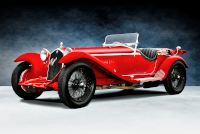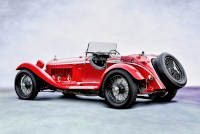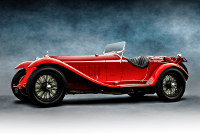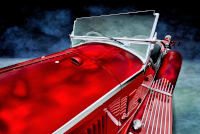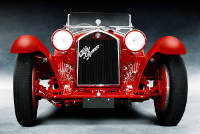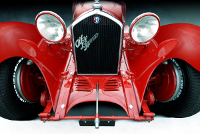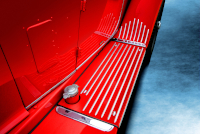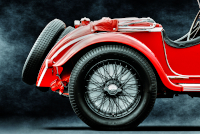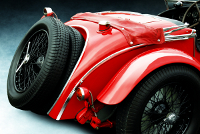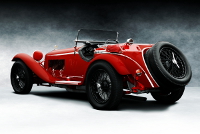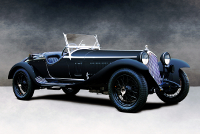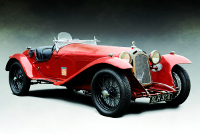Location:
St. Michaels Concours d'Elegance, 2011
Owner: Nancy & John Kendall | Marion, Massachusetts
Prologue:
Another foundational Alfa from the classic era of Mille Miglia competition, where the line between road and race depended mainly on how fast one was willing to drive. Alfa Romeo tailors production to this sort of endurance road race endeavor, which establishes a more familiar sporting character than, say, Maserati, who focus on Formula One and Formula Two competition. That the 8C Alfa would compete with the 8C Maserati is impressive, and speaks to the persistent development of the platform. Whatever the purpose, Maserati would have drawn a clean sheet and produced two or three cars with furious intensity.
So the completeness of the 8C 2300 lies in is its affability, perhaps like a horse of good manners that also happens to be quite fast. The example represents the breed quite well, and demonstrates the Zagato coachwork transposition from the 6C to the 8C with minimal alteration save for the dimensions.
About the images, in the early days of 12cylinders, back when I tried fruitlessly to achieve a Michael Furman aesthetic without any of the necessary resources, I often stumbled into the Michel Zumbrunn style. My formative process lent itself to his approach—simple, lighted surveys of automobiles created onsite. Zumbrunn's mobile studio concept fits. Over time I broke out of that repetition. But surveys like this often began with a four-shot walk-around, maybe with an added detail or two. Here, I took the opportunity to dig up some additional snaps many years later and tried to advance the concept slightly. The result doesn't quite gel with our newer material, but bridges the gap in terms of how far we can stretch old media.
- - - - - - - - - -
► Image Source: Nikon D200 (10.2 MP) | Image Source 4, 5, 7, and 8 by E, illustrated by the author.
References:
- Hales, Mark; Mason, Nick. "At The Limit: Twenty-one classic cars that shaped a century of motor sport" MBI Publishing Company, Osceola, WI. 1988, page 30-35
- Bonhams: A lovely 1932 8C 2300 MM Spider by Zagato sold at Goodwood in 2007 for £1.4 million, chassis #2211051.
- Museo Nazionale Scienza e Technologia Leonardo Davinci: Technical figures once were available from this Italian source. Zagato also kept detailed information online, but no longer.
- UltimateCarPage: History and photographs on the 8C 2300 Spider Zagato, by Wouter Melissen, June 17, 2015.
- Dennis David GP History: Year-by-year Mille Miglia history, featuring 1932 in this edition, (now part of Sports Car Digest).
- TravelingWithTools: Mechanic Greg Stasko illustrates the nuances of Vittorio Jano's 8C motor in a way we simply cannot do from the outside.
The Alfa Romeo 8C 2300 won Le Mans outright from 1931 to 1934, and won the Mille Miglia outright in 1932 and 1933. Purpose-built for road racing, drivers preferred the long-chassis version for Le Mans and the short-chassis for the Mille Miglia. A third configuration, the lighter, faster 8C 2300 Monza, found victory in all manner of international events, including Grand Prix competition. Among this cadre of classic era thoroughbreds, chassis #2111015 competed in three consecutive Mille Miglia races, from 1932 to 1934.
The history of the 1932 Mille Miglia reads as a Who's Who of classic motorsport. But, whether focusing on the top finishers—Baconin Borzacchini, Count Trossi, and Ludovico Scarfiotti—or those who failed to finish this year—Caracciola, Nuvolari, and Taruffi—most dressed themselves in an Alfa 8C 2300. Eventually, nine out of the top ten spots fell to this model, Borzacchini winning with mechanic Amedeo Bignamini alongside. As to chassis #2111015, G.B. Santinelli drove home in seventh place in 1932. In the 1933 edition he bettered that performance by one position, before finally wrapping up participation in 1934 with a 25th place spot. Three consecutive Mille Miglia finishes, and two in the top ten, makes for a well accomplished car in period.
After a restoration in 2004, chassis #2111015 ventured back to Italy to compete in the modern Mille Miglia.
Motor: 2,336 cc straight 8-cylinder, aluminum block, aluminum hemi-head | 65 mm x 88 mm | 6.6:1 compression
Vittorio Jano's race-prepared 8C motor uses a magnesium crankcase with aluminum main caps. On the case sit two aluminum cylinder blocks with iron liners, topped by a separate cylinder head formed in two 4-cylinder sections.
Valvetrain: DOHC, 2 valves per cylinder, gear-driven via a central mechanism between each 4-cylinder block
The center of the crankshaft uses a sprung gear hub to control tolerance between both halves. Each camshaft is two pieces joined at the cam gear in the middle.
Aspiration: Memini twin-choke carburetor, Roots-type supercharger
Power: 155 bhp at 5,000 rpm
Drivetrain: 4-speed gearbox, rear-wheel drive
Mark Hales describes the business of moving the 8C 2300 Zagato as follows: "The gearlever streches up and back like a curved wand, sprouting from a dinky little chrome-plated gate atop the gearbox. Flop the lever about the neutral groove and it feels so light and easy that the gearbox might be missing. Move it left and forward to the first of the two forward gates and feel the grind of every tooth as the gears engage. There's no effort, but as with the Bugatti, you just cannot hurry. If the grating offends, the only way is to wait an age for the gears to stop stirring."
Front Suspension: beam axle, semi-elliptic leaf springs, friction dampers
Rear Suspension: live axle, semi-elliptic leaf springs, friction dampers
Architecture: pressed steel chassis with aluminum coachwork by Zagato of Terrazzano di Rho, Lombardia
Of Nick Mason's Zagato-boded 8C 2300, chassis #2111007, Mark Hales describes the driving characteristic as only he can: "But while you may be motionless, the Alfa is certainly not. All the time you can feel the car rearranging itself. The dash moves one way, the seat moves another. The bonnet, with its mass of complex chromed catches, shimmies behind the radiator as the floor gently quakes beneath your feet. The long sweeping mudguards flap up and down like the wings of a bird gently shedding water. Every part has its own direction and the whole experience is more animal than mechanical."
With each example of the series may be different owing to its history and present condition, I rather like Hales' impression, and believe the story well enough representative of the same chassis and same coachwork to reprint for our enjoyment.
Kerb Weight: 1,000 kg (2,205 lbs)
Wheelbase: 2,750 mm (108.3 inches)
Top Speed: 185 km/h (about 115 mph)
Etymology:
'8C 2300' refers to the motor configuration, a straight 8-cylinder of about 2.3 litres displacement. 'Mille Miglia Spider' indicates that the car was prepared for competition in the Mille Miglia, Italy's premier endurance road race. 'Zagato' calls out the Milanese coachbuilder who bodied many classic Alfa racing cars in lightweight aluminum coachwork. Carrozzeria Touring would have been the other popular choice, although Alfa Romeo was not exclusive to these two firms.
Figures:
Various internet sources cite that Alfa Romeo built anywhere between 188 and 195 8C 2300 cars; this number may refer to racing devices—short and long chassis, Monza included—many of which were aimed at specific international events. The Alfa factory cites over 300 8C 2300 cars built from 1931 to 1934. Alfa Romeo built these cars in three series, with an additional group provided specially for Scuderia Ferrari. Of 50 first series 8C 2300 cars, perhaps half survive today.
Comparison Points: Differences among Fifth Series 6C and 8C Zagato Designs
The first comparison point is the fifth series 6C 1750 Zagato-bodied car of the same year, #10814368. At a glance, the 8C appears to be an identical design on a more capable platform. The running gear, chrome, doors, bonnet louvres, windscreen, retractable hood, and tail all follow the same form. In this case, Zagato's expertise is rather applying mirror-image proportions using hand-made techniques.
The 8C wheelbase differs from the 6C only by the addition of five millimeters, and yet appears much longer and leaner. In contrast, the second comparison point, the 8C 2300 Touring Spider, retains a powerful, stocky posture. Zagato maintained a level line of attack, whereas Touring worked with a leaping pitch, often accentuated by the streamlined helmet over the spares. Touring brought more style to the platform, whereas the Zagato design focuses on light, clean execution.
One of the most noticeable differences between the 6C and 8C cars should be the massive 15½-inch brake drums. The drums hint at power, capable of wrangling speeds in excess of 100 miles per hour, looking mean between the beautiful red backing plates and black 19-inch wire wheels.
Straight Sport: An Economic Racing Design
Zagato wove a complete body around the basic 8C 2300 platform, which is nonetheless capable of enduring 1,000 grueling miles of primitive Italian roads. The chrome belt line stands out as the primary piece of ornament. Carrying along the flanks, the cut-down doors abbreviate the chrome, which then picks up again to move over the lovely, curt tail. Chrome lines the edge of the door itself, while the running gear uses an arrangement of eight chrome speed strakes. Together, chassis #2111015 contains a lot of brightwork, but all of it is straight and purposeful—nice, without being frivolous.
Remembering that endurance racing once meant driving at race pace for 14 hours over public roads, teams maintained a supply of tyres while far away from the towns where mechanical assistance might have been available. Zagato's treatment of the spare tyre cove is simple, but nice—a chrome-lined porthole carved into the back, with well constructed fixtures throughout the deck.
Last Updated: Mar 26, 2025

